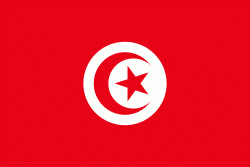Hergla (Harqalah)
Hergla (هرقلة) is a small cliff-top town in north-eastern Tunisia at the Gulf of Hammamet. White houses of Hergla with often blue window and door surroundings are built in the classic style characteristic for Tunisia. Sousse is about 24 km south-east of Hergla. There is a lagoon between Hergla and its neighbour town Chott Meryem in the south-east called Halk el menzel (sickle lake).
In the Roman period Hergla was named "Horrea Caelia". In the 3rd century CE it was the border town between the historic regions Byzacena with the capital Hadrumete (nowadays Sousse) and Zeugitana with the capital Carthago. The etymology of Hergla is still unclear: It might either refer to the "horreas" (i.e. store houses for trade), to the Greek god Heracles or to the word "frontier town". However, there is prove that a roman family called Caelii settled in Horrea Caelia underscoring the first theory. In the 6th century CE Byzantines built a fortification. After the Arab conquest in the 7th century CE the population was utterly killed.³ Close to the seaside there are still remainders of both roman and Byzantine foundations.
In the Roman period Hergla was named "Horrea Caelia". In the 3rd century CE it was the border town between the historic regions Byzacena with the capital Hadrumete (nowadays Sousse) and Zeugitana with the capital Carthago. The etymology of Hergla is still unclear: It might either refer to the "horreas" (i.e. store houses for trade), to the Greek god Heracles or to the word "frontier town". However, there is prove that a roman family called Caelii settled in Horrea Caelia underscoring the first theory. In the 6th century CE Byzantines built a fortification. After the Arab conquest in the 7th century CE the population was utterly killed.³ Close to the seaside there are still remainders of both roman and Byzantine foundations.
Map - Hergla (Harqalah)
Map
Country - Tunisia
 |
 |
| Flag of Tunisia | |
Beginning in early antiquity, Tunisia was inhabited by the indigenous Berbers. Phoenicians began to arrive in the 12th century BC, establishing several settlements, of which Carthage emerged as the most powerful by the 7th century BC. Carthage was a major mercantile empire and a military rival to the Roman Republic until 146 BC, when it was defeated by the Romans who occupied Tunisia for most of the next 800 years. The Romans introduced Christianity and left architectural legacies like the Amphitheatre of El Jem. In the 7th century AD, Arab Muslims conquered all of Tunisia (finally succeeding in 697 after several attempts starting in 647) and settled with their tribes and families, brought Islam and Arab culture to the local inhabitants, and since then Arabs became the majority of the population. Then, in 1546, the Ottoman Empire established control there, holding sway for over 300 years, until 1881, when the French conquered Tunisia. In 1956, Tunisia gained independence as the Tunisian Republic under the leadership of Habib Bourguiba with the help of activists such as Chedly Kallala, Farhat Hached and Salah Ben Youssef. Today, Tunisia's culture and identity are rooted in this centuries-long intersection of different cultures and ethnicities.
Currency / Language
| ISO | Currency | Symbol | Significant figures |
|---|---|---|---|
| TND | Tunisian dinar | دت | 3 |
| ISO | Language |
|---|---|
| AR | Arabic language |
| FR | French language |















